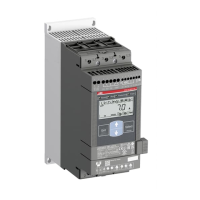J
Johnny MoralesAug 17, 2025
Why is my ABB Controller showing softstarter thermal overload?
- CchaneydennisAug 17, 2025
A softstarter thermal overload in the ABB Controller indicates that the thyristors have overheated.

Why is my ABB Controller showing softstarter thermal overload?
A softstarter thermal overload in the ABB Controller indicates that the thyristors have overheated.
What causes high current in ABB PSE18?
High current in the ABB Controller can be caused by the operational current being higher than 8 x Ie.
What causes electronic motor overload protection in ABB PSE18 Controller?
Electronic motor overload protection is triggered when the load on the motor is higher than the motor rating and the corresponding selected EOL Class, or if the current limit parameter is set to a value that is too low.
What causes a shunt fault in an ABB Controller?
A shunt fault can occur if the by-pass relay does not open or if there is a thyristor short circuit.
What causes a locked rotor protection fault on my ABB Controller?
Locked rotor protection is activated when the load on the motor is too high for a short time.
What does it mean when my ABB Controller shows 'By-pass open'?
The 'By-pass open' error means that the by-pass relay or by-pass contactor does not close.
What causes a fieldbus fault on an ABB PSE18?
A fieldbus fault is caused by a fault on Fieldbus communication.
What does it mean when my ABB PSE18 shows current lost?
Current lost indicates that the operational current on one or several phases is lost.
Why does my ABB PSE18 Controller have bad network quality?
Bad network quality is due to excessive disturbances in the operational supply network.
What causes the 'Underload protection' fault on my ABB PSE18?
The 'Underload protection' fault indicates that the load on the motor is too low.
| Rated Operational Current Ie | 18 A |
|---|---|
| Rated Impulse Withstand Voltage | 6 kV |
| Rated Frequency | 50 / 60 Hz |
| Number of Poles | 3 |
| Protection class | IP20 |
| Operating temperature range | -25 ... +60 °C |
Explains caution, warning, information, and graphics symbols used in the manual.
Covers safe mounting, unpacking, lifting, and service procedures for the softstarter.
Details standard features, operating voltage, and environmental requirements.
Covers hardwire/fieldbus control, product verification, and short circuit protection.
Outlines safety precautions, power supply, and motor connection procedures.
Guides on connecting control supply, earth, and signal output relays with warnings.
Step-by-step instructions for configuring the motor's rated current parameter.
Explains how to use the Human Machine Interface (HMI) for functions and settings.
Lists event codes and their causes for diagnosing issues.